North America Trade Finance Market Size
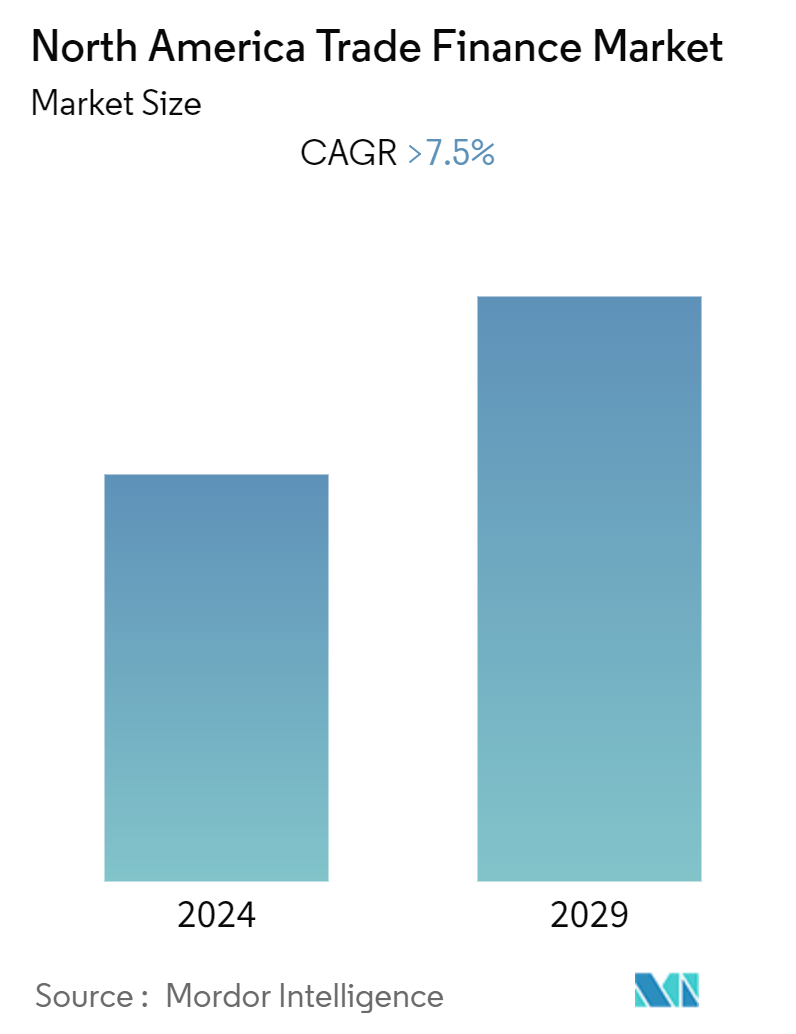
| Study Period | 2020- 2029 |
| Base Year For Estimation | 2023 |
| Forecast Data Period | 2024 - 2029 |
| Historical Data Period | 2020 - 2022 |
| CAGR (2024 - 2029) | 7.50 % |
| Market Concentration | Medium |
Major Players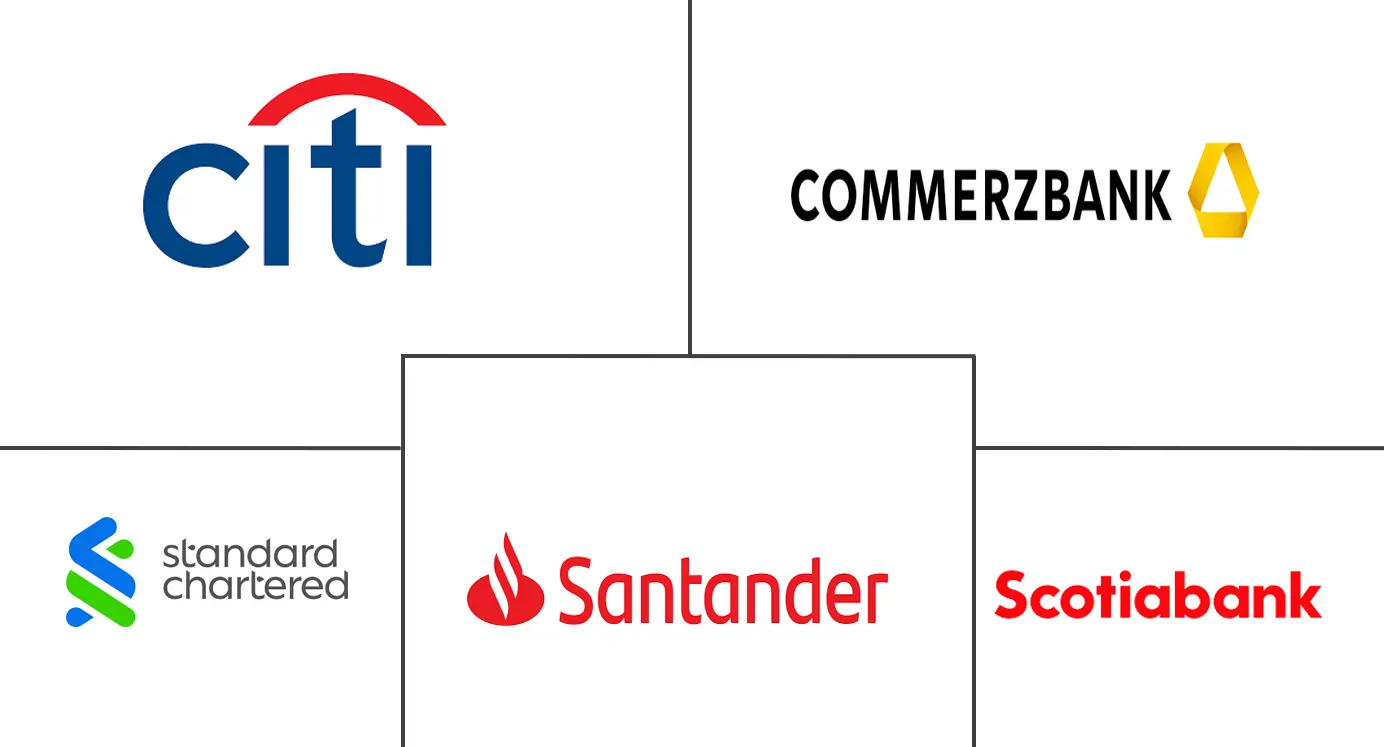
*Disclaimer: Major Players sorted in no particular order |
North America Trade Finance Market Analysis
The North America Trade Finance Market is expected to register a CAGR of greater than 7.5% during the forecast period.
The financial tools and goods used by businesses to support international trade and commerce are referred to as trade finance. Trade finance makes it possible and easier for importers and exporters to conduct business through trade. Trade finance offers a variety of financial products by banks and other financial institutes to businesses and facilitates trade transactions. Lending, factoring, forfeiting, giving letters of credit, and export credit and financing are a few examples of trade finance. According to the World Trade Organization, trade finance facilitates and supports up to 90% of international trade.
North America holds more than one-fourth of the global trade finance market, with high-end technology playing a bigger role in trade financing. Blockchain technology in trade finance businesses is offering attractive business opportunities in the region. The region's trade finance sector is expanding as a result of the rising use of technology, an increase in SMEs embracing trade financing, increased competition, and new trade agreements. The use of digital technology by multinational firms in the US promises improved trade finance. The market is fueled by the rising total value of international trade imports and exports.
The COVID-19 pandemic affected all aspects of human life, including the economy. Investments, transactions, and other financial services got a surprising shock as the effects of the pandemic. North America countries took stringent measures to combat the viral infection and limited its human-to-human spread, including the closure of numerous commercial and industrial operations. The availability of funding during the COVID-19 pandemic, when formal lending institutions were reluctant to lend, came at a high cost, discouraging enterprises, particularly SMEs, from borrowing. Pandemic increased macroeconomic uncertainty and banks' increased fear of default, risk, a higher percentage of SME application rejections, 40%, was experienced. Faster vaccine distribution helped the North America regions economy recover from 2021. As time goes by, the pandemic started to renormalize turning into a new normal. COVID-19's impact on trade finance can also be defined as a 'positive discontinuity' for the purpose of digitization of the sector and the ability to offer an excellent customer experience. With the economy on track to bounce back from the worst of the pandemic. Post COVID-19 the trade finance providers pushed to move their trade finance transactions which were essentially paper-based to digital platform.
North America Trade Finance Market Trends
Technology Implementation in Trade Finance Platforms Makes Way for Startups
Many industries rely on technology, including banking, financial services, and insurance. The pandemic increased digitalization and showed the nature of trade. Digitalization cuts costs, improves efficiencies, and transparency facilitates the coordination of global value chains and globally connects many firms and consumers. In recent years, technological breakthroughs, automation, and a degree of standardization have all been developed in trade financing. The demand for AI and automation in banking is being driven by advancements in data collection technology. Fintech Saphyre received USD 18.7 million from BNP Paribas and JP Morgan in 2022. Modern technology is becoming increasingly important in trade financing in North America. The use of blockchain technology in trade finance is expected to generate lucrative business opportunities over the forecasted period. The overall international trade imports and exports are increasing, which is fueling the growth of the trade finance market.
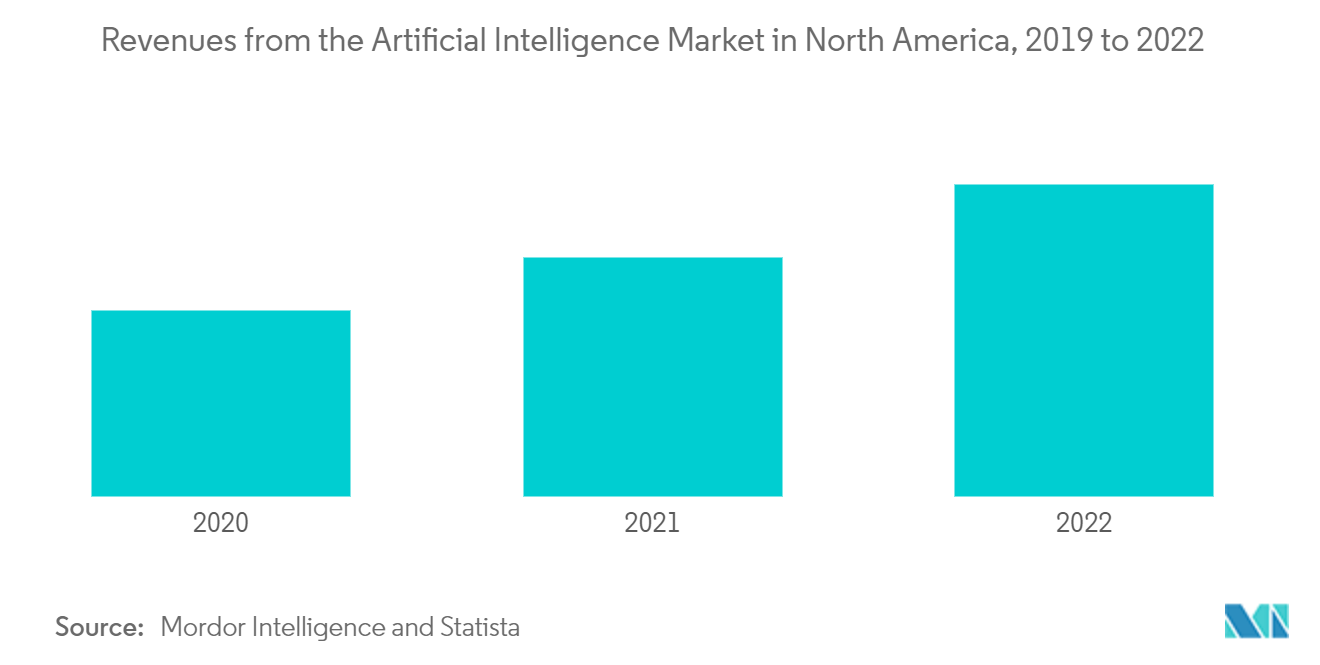
United States Dominates the Market in the North American Region
The United States is the world's second-largest exporter of goods and services exports in 2021, according to the U.S. Census Bureau. However, less than one percent of America's 32 million companies export. And SMEs, which account for 98 percent of American exporters, export to more than one market. SMEs are expanding their sales, diversifying their portfolios, and protecting themselves against periods of slower growth in the domestic economy. Modern technology is becoming increasingly crucial to trade financing in the United States. Adopting blockchain technology in trade finance is anticipated to create lucrative business prospects during the anticipated time period. The demand for safety and security in trading activities is fueling the expansion of the trade finance industry in the United States, along with a surge in SMEs' use of trade financing, more intense competition, and new trade agreements.
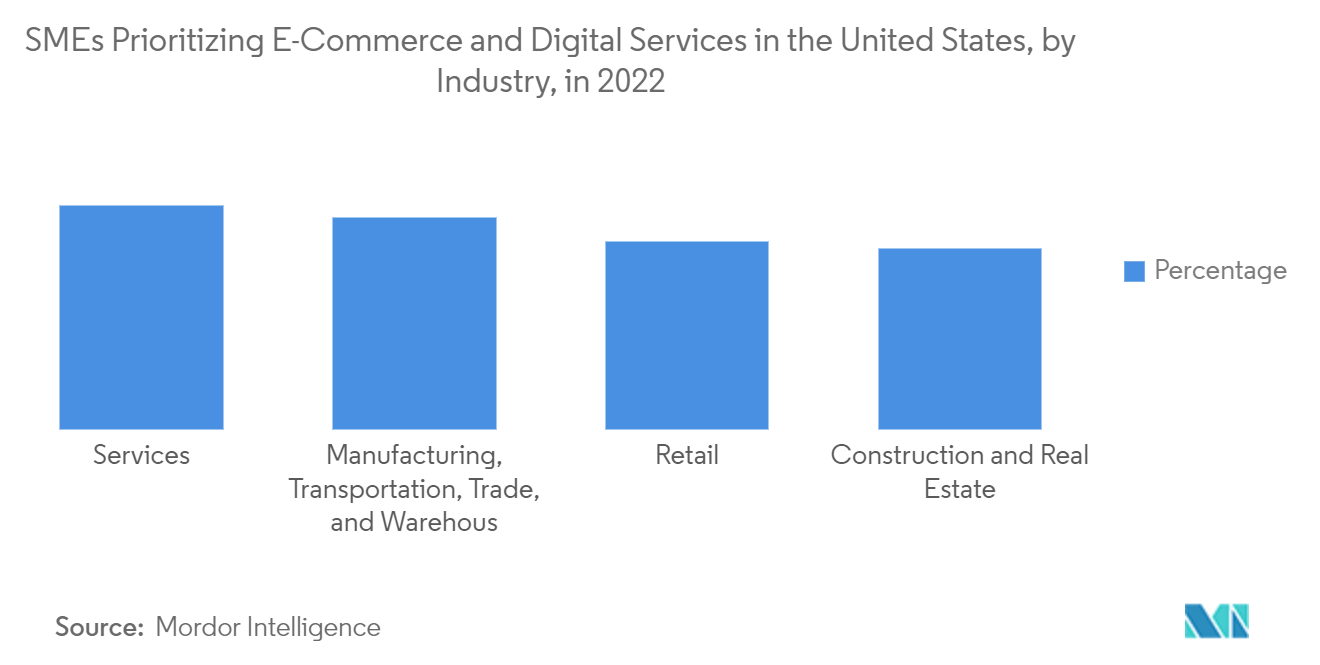
North America Trade Finance Industry Overview
The report provides a general overview of the trade financing market's competition as well as a quick recap of recent merger and acquisition transactions. It includes corporate profiles of a few trade finance and trade technology companies, as well as banks. Some top companies now dominating the market include Santandar, Commerzbank, Citi group Inc., Standard Chartered Bank, and Scotia Bank, among others.
North America Trade Finance Market Leaders
-
Citi group Inc.
-
Commerzbank
-
Santander Bank
-
Scotiabank
-
Standard Chartered Bank
*Disclaimer: Major Players sorted in no particular order
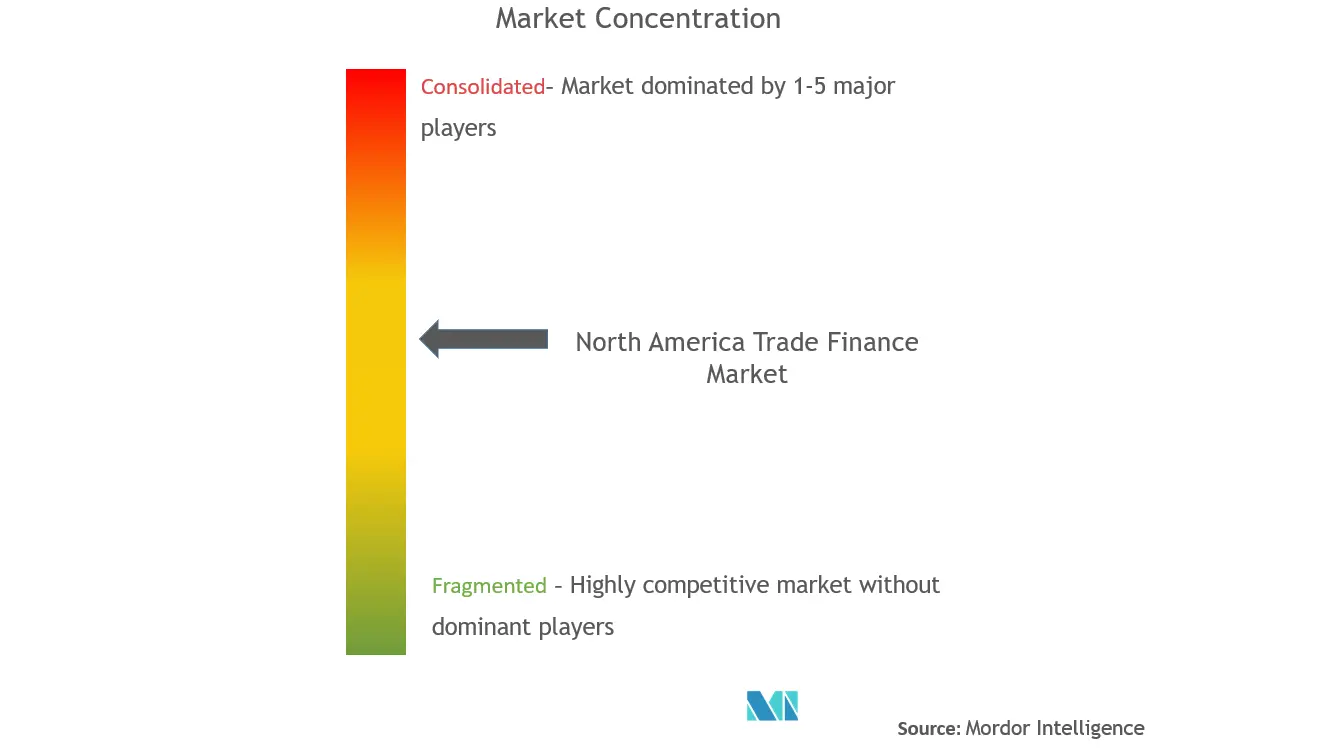
North America Trade Finance Market News
- December 2022: Komgo acquired U.S.-based GlobalTrade Corporation. The two companies provide trade finance digitization solutions to over 120 multinational clients, helping them connect to sources of financing.
- November 2021: Ripple announced the launch of Ripple Liquidity Hub for US banks and fintech firms, which allows users to invest in and trade cryptocurrencies.
North America Trade Finance Market Report - Table of Contents
1. INTRODUCTION
- 1.1 Study Assumptions and Market Definition
- 1.2 Scope of the Study
2. RESEARCH METHODOLOGY
3. EXECUTIVE SUMMARY
4. MARKET DYNAMICS AND INSIGHTS
- 4.1 Market Overview
- 4.2 Market Drivers
- 4.3 Market Restraints
-
4.4 Industry Attractiveness - Porter's Five Forces Analysis
- 4.4.1 Threat of New Entrants
- 4.4.2 Bargaining Power of Buyers
- 4.4.3 Bargaining Power of Suppliers
- 4.4.4 Threat of Substitutes
- 4.4.5 Intensity of Competitive Rivalry
- 4.5 Insights on Impact of Technology and Innovation in Trade Finance Market
- 4.6 Impact of COVID-19 on the Market
5. MARKET SEGMENTATION
-
5.1 By Product
- 5.1.1 Documentary
- 5.1.1.1 Performance Bank Guarantee
- 5.1.1.2 Letter of Credit
- 5.1.1.3 Others
- 5.1.2 Non-Documentary
-
5.2 By Service Provider
- 5.2.1 Banks
- 5.2.2 Trade Finance Companies
- 5.2.3 Insurance Companies
- 5.2.4 Other Service Providers
-
5.3 By Application
- 5.3.1 Domestic
- 5.3.2 International
-
5.4 By Country
- 5.4.1 USA
- 5.4.2 Canada
6. COMPETITIVE LANDSCAPE
- 6.1 Market Concentration & Overview
-
6.2 Company Profiles
- 6.2.1 Bank of America Corporation
- 6.2.2 BNP Paribas S.A
- 6.2.3 Citi group Inc.
- 6.2.4 Commerzbank
- 6.2.5 HSBC
- 6.2.6 Wells Fargo
- 6.2.7 JPMorgan Chase & Co
- 6.2.8 Mitsubishi UFJ Financial Inc.
- 6.2.9 Santander Bank
- 6.2.10 Scotiabank
- 6.2.11 Standard Chartered Bank*
- *List Not Exhaustive
7. MARKET OPPORTUNITIES AND FUTURE TRENDS
8. DISCLAIMER AND ABOUT US
** Subject To AvailablityNorth America Trade Finance Industry Segmentation
Trade finance refers to the financial instruments and goods used by businesses to support international trade and commerce. Commerce financing makes it easier for importers and exporters to conduct trade-related business. North America trade finance market is segmented by product (documentary (performance bank guarantee, letters of credit, and others), non-documentary), by the service provider (banks, trade finance companies, insurance companies, and other service providers), by application (domestic and international), and by country (USA, Canada). The report offers market size and forecasts for the North America trade finance market in values (USD) for the above segments.
| By Product | Documentary | Performance Bank Guarantee |
| Letter of Credit | ||
| Others | ||
| By Product | Non-Documentary | |
| By Service Provider | Banks | |
| Trade Finance Companies | ||
| Insurance Companies | ||
| Other Service Providers | ||
| By Application | Domestic | |
| International | ||
| By Country | USA | |
| Canada |
North America Trade Finance Market Research Faqs
What is the current North America Trade Finance Market size?
The North America Trade Finance Market is projected to register a CAGR of greater than 7.5% during the forecast period (2024-2029)
Who are the key players in North America Trade Finance Market?
Citi group Inc., Commerzbank, Santander Bank, Scotiabank and Standard Chartered Bank are the major companies operating in the North America Trade Finance Market.
What years does this North America Trade Finance Market cover?
The report covers the North America Trade Finance Market historical market size for years: 2020, 2021, 2022 and 2023. The report also forecasts the North America Trade Finance Market size for years: 2024, 2025, 2026, 2027, 2028 and 2029.
North America Trade Finance Industry Report
Statistics for the 2024 North America Trade Finance market share, size and revenue growth rate, created by Mordor Intelligence™ Industry Reports. North America Trade Finance analysis includes a market forecast outlook to for 2024 to (2024to2029 and historical overview. Get a sample of this industry analysis as a free report PDF download.



